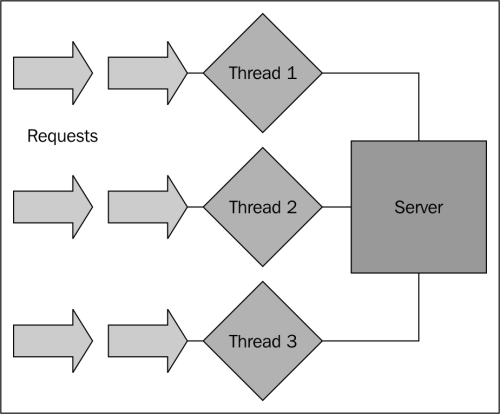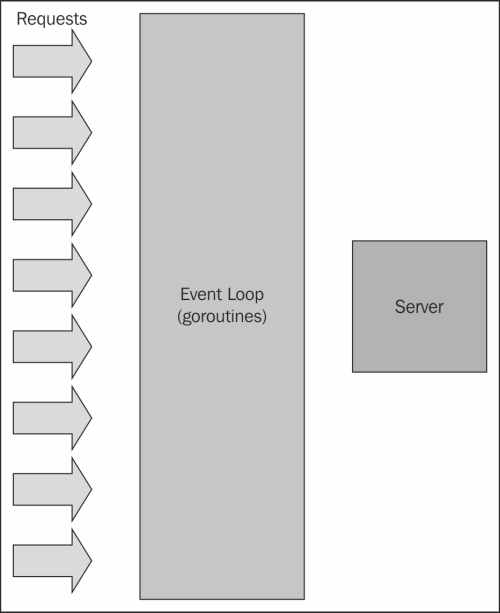Up to this point, we've built a few usable applications; things we can start with and leapfrog into real systems for everyday use. By doing so, we've been able to demonstrate the basic and intermediate-level patterns involved in Go's concurrent syntax and methodology.
However, it's about time we take on a real-world problem—one that has vexed developers (and their managers and VPs) for a great deal of the early history of the Web.
In addressing and, hopefully, solving this problem, we'll be able to develop a high-performance web server that can handle a very large volume of live, active traffic.
For many years, the solution to this problem was solely to throw hardware or intrusive caching systems at the problem; so, alternately, solving it with programming methodology should excite any programmer.
We'll be using every technique and language construct we've learned so far, but we'll do so in a more structured and deliberate way than we have up to now. Everything we've explored so far will come into play, including the following points:
- Creating a visual representation of our concurrent application
- Utilizing goroutines to handle requests in a way that will scale
- Building robust channels to manage communication between goroutines and the loop that will manage them
- Profiling and benchmarking tools (JMeter, ab) to examine the way our event loop actually works
- Timeouts and concurrency controls—when necessary—to ensure data and request consistency
The genesis of the C10K problem is rooted in serial, blocking programming, which makes it ideal to demonstrate the strength of concurrent programming, especially in Go.
The proposed problem came from developer Dan Kegel, who famously asked:
It's time for web servers to handle ten thousand clients simultaneously, don't you think? After all, the web is a big place now. | ||
| --Dan Kegel (http://www.kegel.com/c10k.html) | ||
When he asked this in 1999, for many server admins and engineers, serving 10,000 concurrent visitors was something that would be solved with hardware. The notion that a single server on common hardware could handle this type of CPU and network bandwidth without falling over seemed foreign to most.
The crux of his proposed solutions relied on producing non-blocking code. Of course, in 1999, concurrency patterns and libraries were not widespread. C++ had some polling and queuing options available via some third-party libraries and the earliest predecessor to multithreaded syntaxes, later available through Boost and then C++11.
Over the coming years, solutions to the problem began pouring in across various flavors of languages, programming design, and general approaches. At the time of publishing this book, the C10K problem is not one without solutions, but it is still an excellent platform to conduct a very real-world challenge to high-performance Go.
Any performance and scalability problem will ultimately be bound to the underlying hardware, so as always, your mileage may vary. Squeezing 10,000 concurrent connections on a 486 processor with 500 MB of RAM will certainly be more challenging than doing so on a barebones Linux server stacked with memory and multiple cores.
It's also worth noting that a simple echo server would obviously be able to assume more cores than a functional web server that returns larger amounts of data and accepts greater complexity in requests, sessions, and so on, as we'll be dealing with here.
As you may recall, when we discussed concurrent strategies back in Chapter 3, Developing a Concurrent Strategy, we talked a bit about Apache and its load-balancing tools.
When the Web was born and the Internet commercialized, the level of interactivity was pretty minimal. If you're a graybeard, you may recall the transition from NNTP/IRC and the like and how extraordinarily rudimentary the Web was.
To address the basic proposition of [page request] → [HTTP response], the requirements on a web server in the early 1990s were pretty lenient. Ignoring all of the error responses, header readings and settings, and other essential (but unrelated to the in → out mechanism) functions, the essence of the early servers was shockingly simple, at least compared to the modern web servers.
Note
The first web server was developed by the father of the Web, Tim Berners-Lee.
Developed at CERN (such as WWW/HTTP itself), CERN httpd handled many of the things you would expect in a web server today—hunting through the code, you'll find a lot of notation that will remind you that the very core of the HTTP protocol is largely unchanged. Unlike most technologies, HTTP has had an extraordinarily long shelf life.
Written in C in 1990, it was unable to utilize a lot of concurrency strategies available in languages such as Erlang. Frankly, doing so was probably unnecessary—the majority of web traffic was a matter of basic file retrieval and protocol. The meat and potatoes of a web server were not dealing with traffic, but rather dealing with the rules surrounding the protocol itself.
You can still access the original CERN httpd site and download the source code for yourself from http://www.w3.org/Daemon/. I highly recommend that you do so as both a history lesson and a way to look at the way the earliest web server addressed some of the earliest problems.
However, the Web in 1990 and the Web when the C10K question was first posed were two very different environments.
By 1999, most sites had some level of secondary or tertiary latency provided by third-party software, CGI, databases, and so on, all of which further complicated the matter. The notion of serving 10,000 flat files concurrently is a challenge in itself, but try doing so by running them on top of a Perl script that accesses a MySQL database without any caching layer; the challenge is immediately exacerbated.
By the mid 1990s, the Apache web server had taken hold and largely controlled the market (by 2009, it had become the first server software to serve more than 100 million websites).
Apache's approach was rooted heavily in the earliest days of the Internet. At its launch, connections were initially handled first in, first out. Soon, each connection was assigned a thread from the thread pool. There are two problems with the Apache server. They are as follows:
- Blocking connections can lead to a domino effect, wherein one or more slowly resolved connections could avalanche into inaccessibility
- Apache had hard limits on the number of threads/workers you could utilize, irrespective of hardware constraints
It's easy to see the opportunity here, at least in retrospect. A concurrent server that utilizes actors (Erlang), agents (Clojure), or goroutines (Go) seems to fit the bill perfectly. Concurrency does not solve the C10k problem in itself, but it absolutely provides a methodology to facilitate it.
The most notable and visible example of an approach to the C10K problem today is Nginx, which was developed using concurrency patterns, widely available in C by 2002 to address—and ultimately solve—the C10k problem. Nginx, today, represents either the #2 or #3 web server in the world, depending on the source.
There are two primary approaches to handle a large volume of concurrent requests. The first involves allocating threads per connection. This is what Apache (and a few others) do.
On the one hand, allocating a thread to a connection makes a lot of sense—it's isolated, controllable via the application's and kernel's context switching, and can scale with increased hardware.
One problem for Linux servers—on which the majority of the Web lives—is that each allocated thread reserves 8 MB of memory for its stack by default. This can (and should) be redefined, but this imposes a largely unattainable amount of memory required for a single server. Even if you set the default stack size to 1 MB, we're dealing with a minimum of 10 GB of memory just to handle the overhead.
This is an extreme example that's unlikely to be a real issue for a couple of reasons: first, because you can dictate the maximum amount of resources available to each thread, and second, because you can just as easily load balance across a few servers and instances rather than add 10 GB to 80 GB of RAM.
Even in a threaded server environment, we're fundamentally bound to the issue that can lead to performance decreases (to the point of a crash).
First, let's look at a server with connections bound to threads (as shown in the following diagram), and visualize how this can lead to logjams and, eventually, crashes:

This is obviously what we want to avoid. Any I/O, network, or external process that can impose some slowdown can bring about that avalanche effect we talked about, such that our available threads are taken (or backlogged) and incoming requests begin to stack up.
We can spawn more threads in this model, but as mentioned earlier, there are potential risks there too, and even this will fail to mitigate the underlying problem.
In an attempt to create our web server that can handle 10,000 concurrent connections, we'll obviously leverage our goroutine/channel mechanism to put an event loop in front of our content delivery to keep new channels recycled or created constantly.
For this example, we'll assume we're building a corporate website and infrastructure for a rapidly expanding company. To do this, we'll need to be able to serve both static and dynamic content.
The reason we want to introduce dynamic content is not just for the purposes of demonstration—we want to challenge ourselves to show 10,000 true concurrent connections even when a secondary process gets in the way.
As always, we'll attempt to map our concurrency strategy directly to goroutines and channels. In a lot of other languages and applications, this is directly analogous to an event loop, and we'll approach it as such. Within our loop, we'll manage the available goroutines, expire or reuse completed ones, and spawn new ones where necessary.
In this example visualization, we show how an event loop (and corresponding goroutines) can allow us to scale our connections without employing too many hard resources such as CPU threads or RAM:

The most important step for us here is to manage that event loop. We'll want to create an open, infinite loop to manage the creation and expiration of our goroutines and respective channels.
As part of this, we will also want to do some internal logging of what's happening, both for benchmarking and debugging our application.
